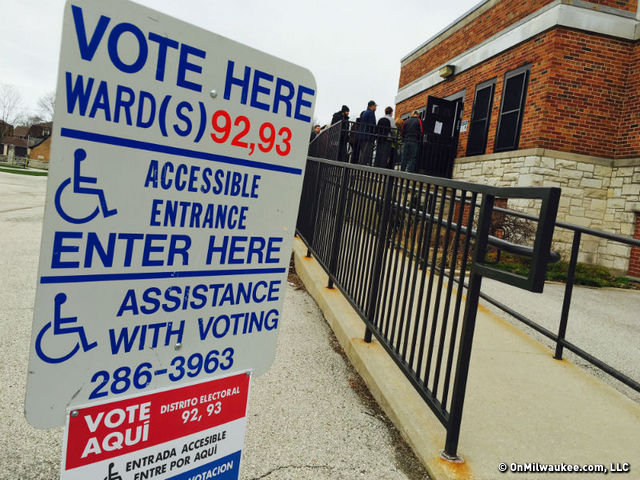The opinions expressed in this piece do not necessarily reflect the opinions of OnMilwaukee.com, its advertisers or editorial staff.
If my NCAA bracket is any indication, I should really, really never make predictions. But in this space a couple of months ago, I did just that, going waaaaaaay out on a limb to suggest that Wisconsin's April 5 vote would be significantly affected by what happened a month before on the so-called "Super Tuesday" vote in March.
How did I do? About as well as my NCAA bracket.
That's not necessarily the case, I suppose, since, like any good fortune-teller, I peppered that column with lots of generalities and could-go-either-ways.
But I did make one specific prediction, with numbers and everything. "All else being equal," I wrote about the race for Milwaukee mayor, "I'm predicting a 60/40 Barrett win." All else was equal, but Tom Barrett dominated with 70 percent of the vote against Ald. Bob Donovan.
I start with that result, not just because I was so very wrong with it, but why.
Let me take a step back: Obviously, Milwaukee is a Democratic stronghold. In 2008 and 2012, the city voted 4-1 for Barack Obama over his Republican opponents. In the 2010 and 2014 elections, the city went 3-1 in favor of Republican Scott Walker's Democratic opponents, Barrett and Mary Burke.
However, last week I was expecting two things. One, I was expecting the anti-Barrett side to be better organized and better funded than they actually were. And two, while I didn't think Ald. Joe Davis's endorsement of Donovan would be worth much with the African American community, I did think the still-going Republican Presidential Primary would give Donovan more of an edge in the city than he otherwise would have had.
Indeed, Republican presidential primary turnout more than doubled in the city since the spring of 2008, and last week it was even up by almost 20 percent over 2012's Republican primary, when Rick Santorum was still making a good a run at Mitt Romney, the eventual nominee.
Democratic turnout, on the other hand, was almost exactly the same in the city last week as it was in 2008, the last time the Democrats had a contested primary. However, the higher GOP turnout alone wasn't enough to get Donovan as close to Barrett as I thought it might.
In the end, Donovan outpolled the three remaining Republican candidates combined (Ted Cruz, Donald Trump and John Kasich) by almost 8,000 votes in the city; had anti-Barrett opposition been better organized – and Bruce Murphy here details how inept those efforts turned out to be – Donovan might have gotten closer to the 40 percent target I set for him.
Which leads me to the Chris Abele-Chris Larson race for Milwaukee County Executive. I didn't put it in writing, because it would be harder to make fun of me were I wrong, but I expected a close race, 52/48 at the widest, and I wasn't entirely sure which Chris would win. It was in reality kind of a blowout, with Abele taking 56 percent of the vote county-wide.
What's surprising, though, is that Abele also won the City of Milwaukee by about 1,200 votes. That's less than 1/10th of one percent and shows Larson was not weak in the city, but before the vote, I pretty firmly believed that Larson's base in the city was significantly stronger than Abele's. In fact, according to a municipality breakdown by Milwaukee Magazine, Larson won only Shorewood, with most suburban locales breaking quite heavily for the incumbent Abele.
Larson's loss in the city has to hurt groups like the AFSCME (most county employees' union) and the Milwaukee Teachers Education Association (the MPS teachers' union, of which I am a member), who banked heavily on city turnout for Larson. Even though AFSCME- and MTEA-endorsed candidates did well elsewhere, County Executive was the one race they needed to win and couldn't. Despite the lifting of residency rules, most of those unions' members, I'd wager, still live and vote in the city – and as noted, Larson lost the city.
It gets even weirder when you compare the Abele-Larson race to what happened in the Democratic presidential primary. Larson spent much of the stretch between the primary – where he outpolled Abele by more than 700 votes – and last week drawing strong parallels between his campaign and that of Bernie Sanders. For the last couple of weeks, it seemed like most my Facebook friends' profile pictures were of Chris Larson wearing Sanders' trademark glasses and crazy white hair.
Milwaukee County was the only county in the state where Sanders lost to Hillary Clinton, and her winning margin came entirely from within the city. She won the county by about 7,000 votes, but won the city by more than 8,000 votes. In other words, Sanders actually polled slightly better among Democrats in the suburbs of Milwaukee County, where the actual Democrat Larson lost big to nominal Democrat Abele. In the end, Larson far outpolled Sanders in the City of Milwaukee, getting about 18,000 more votes than the presidential candidate did.
Clinton undoubtedly won the city because of her continued nation-wide popularity with African American voters. Looking at ward-by-ward results, Clinton vastly outperformed Sanders in wards comprised mostly of African American voters. Those voters also favored Barrett last week, unsurprisingly. Yet they don't show much of a pattern when it comes the County Executive race, with some heavily black wards going strongly for Larson, some for Abele and many split nearly even.
Again, this has to be tough for Larson and his backers. One of the strongest themes of the anti-Abele campaign was that Abele is not a friend of the black community. That argument has some merit, though Abele would argue – and often did – that his work on things like the Fatherhood Initiative did in fact show strong support for Milwaukee's African American population.
This, in the end, was one of the most contradictory parts of the Larson coalition's message. Larson made a critical decision to align himself with Sanders, who was never going to poll well in Milwaukee's majority-black wards or win the city's vote overall, while at the same time trying to sell the notion that he was African Americans' better option in the County Executive race.
In the end, winning the city's African American votes alone probably would not have swung the race to Larson. I'm sure many of Abele's votes came from suburban Milwaukee County Republicans, who collective cast about 70,000 more votes in the Republican primary than did Republicans in the city, far more than Larson could have made up with black city votes alone.
But this brings me to my last point: I didn't make any predictions about what the effect of Wisconsin's new voter ID law would be. Mostly I figured that primaries, even highly contested ones like last week's, don't bring the kind of turnout that general elections do, and primary voters are more likely to be on the ball when it comes to required ID and the like. If there were to be a massive problem caused by voter ID requirements, I thought, it would be more likely to manifest in November than in April.
But there were some critical issues that appeared. Only 363 provisional ballots were cast, according to WPR, meaning voters who needed to show a valid ID by last Friday for their ballots to count, which is a drop in the proverbial ocean of actual votes cast on Tuesday.
However, the reports of other problems at the polls were many, from long lines to voters simply being turned away (here's one such story). Some Wisconsin Republicans accidentally said the quiet parts out loud, with both U.S. Rep. Glenn Grothman and a former Wisconsin legislative staffer explaining that voter ID was designed not to stop fraud, but to stop Democrats. And the biggest voting problems arose among likely Democratic constituents, like college students.
Remember above, when I said that Democratic turnout in the City of Milwaukee was unchanged since 2008? Why is that? The city has grown since then, and surely not all of it is Republican, the side that did see higher turnout. Dane County's Democratic turnout was more than ten percent higher last week than in 2008. But there was a drop in the rest of the state, since Wisconsin's Democratic primary turnout as a whole was in fact down by about 10 percent over 2008.
Is this the fault of voter ID, with Democrats being shut out of the process across Wisconsin because, as Grothman and others suggest, voter ID is a way to suppress the Democratic vote? I don't know, since nationally, Democratic turnout is also down almost across the board. Daily Caller noted last week that in almost every state to vote so far, fewer Democrats have turned out than they did in 2008.
To an extent, this reinforces what I said after the Milwaukee Democratic debate, that Sanders' claims of bringing a revolution of new voters to the polls just doesn't hold water. It also suggests that if voter ID did, in this smaller-turnout primary election, suppress Democratic votes, it was probably not enough to have made much of a difference in the outcome of the election – at least not for Chris Larson, Sanders or Clinton.
But the long lines – especially at universities – people turned away and provisional ballots do indicate a problem. In a close November election, voter ID may well work as intended and suppress enough Democratic votes to flip Wisconsin, the purplest of swing states, from its decades-long support of Democratic presidential candidates.
If that happens, it will not be because Wisconsin agrees more with the likes of Cruz or Trump, but because too many of our voters will be disenfranchised by a hurtful law with clear partisan intent.







